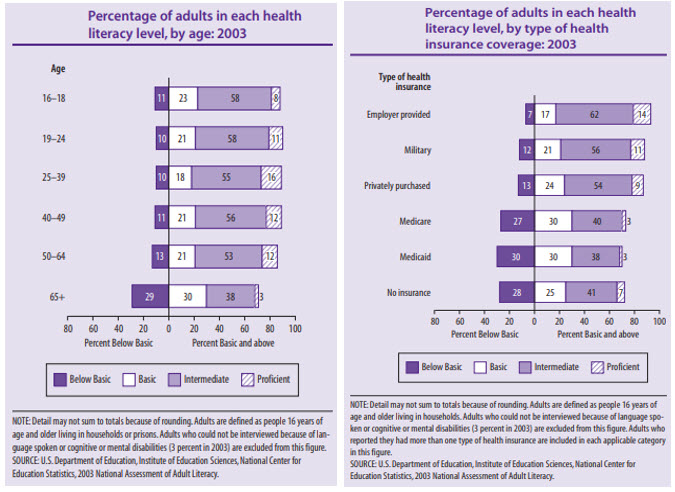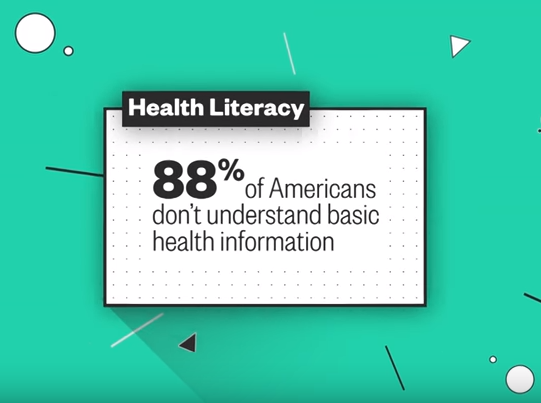Whether you are a patient or an employer providing healthcare benefits, you may feel that the quality of our healthcare delivery system is under threat. But how? Lost amidst concerns about rising healthcare costs, increasingly limited access to healthcare providers, and the ongoing opioid epidemic is a hidden threat to public health that is putting the lives of 77 million people — one in three Americans — at risk. What is it? Lack of basic Health Literacy.
How Widespread is the Problem of Health Literacy?
That’s a question that the US Department of Education wanted to find out in their groundbreaking study of the Health Literacy of America’s Adults. More than 19,000 people aged 16 and over were asked questions about common health-related vocabulary, the typical structure of written health materials, and the workings of the healthcare system.

The results were not encouraging.
- Based on the sample survey, eight million people in the US would not be able to read the label of a bottle of cough medicine to find out what to do in the case of an overdose.
- Similar poor results were found when asking respondents to read an instruction sheet explaining that they need to avoid eating food or drinking liquids starting the night before a diagnostic X-ray procedure.
- On average, only 58% could accurately read a chart to find out how many polio vaccine doses a child should have by the time they are seven years old. But among those with only basic or below basic literacy, the results were far worse. Only 22% of respondents with basic literacy skills could answer the vaccine question correctly. Among those with below basic literacy, the percentage of correct answer dropped to just 5%.
https://www.youtube.com/watch?v=Dlv0Q5ST0vA What’s the bottom line? When it comes to good health, millions of Americans seem to have lost the plot. Researchers found that one in three of us (77 million people) aren’t able to read or follow necessary instructions to make critical healthcare decisions. According to the survey, only about 12% of us command a level of health literacy that allows us to make informed decisions about our healthcare

But even this group is not out of the woods. Researchers found that even the most health literate among us have difficulties when faced with complex or stressful healthcare situations, such as:
- Conditions whose treatment requires detailed knowledge of how the body functions.
- Situations requiring the ability to read and accurately interpret test result numbers.
- The ability to understand the relative risks of different courses of treatment prior to making a health decision.
- Receiving a diagnosis of a serious illness and/or an illness requiring complicated self-care.
What All of Us Should Know about our Health (But Not All of Us Do)
It’s hard to be dispassionate about matters of life and death. Many of us simply don’t want to think about being in poor health or worse, dying. That’s a concern for tomorrow, not today, we tell ourselves. Considering that the life expectancy of an average American is now 78.8 years, that may be true for the many of us. But there are warning signs on the horizon. The most recently published government mortality data (from 2015) shows that average life expectancy actually fell by 0.1 years from the previous year. There is debate as to why, but critics point to an epidemic of obesity and lack of exercise, which in turn, can lead to conditions such as heart disease and diabetes.
There are quite a few lies we tell ourselves about living a healthy lifestyle, such as ordering a diet drink at the drive-through to accompany our super-sized hamburger and fries combo. But what should we really be worried about? According to the National Vital Statistics Reports, here are the top ten health conditions that lead to mortality among Americans:
- Heart Disease
- Cancer
- Chronic lower respiratory diseases, e.g. Chronic Obstructive Pulmonary Disease (COPD), which includes Chronic Bronchitis, Emphysema, and Asthma
- Accidents
- Stroke
- Alzheimer’s disease
- Diabetes
- Influenza and pneumonia
- Kidney disease
- Intentional self-harm (suicide)
What can you do to prevent these conditions? The answer is remarkably simple. Here are five things you can do to improve your overall health:
Quit smoking
Statistics show this is far and away the most important step you can do to improve your health. Smoking can lead to heart disease, lung cancer, various forms of COPD, such as emphysema, and strokes.
Maintain a proper weight
The Body Mass Index (BMI) is a simple screening tool that will tell you if you are overweight for your height.
Perform vigorous exercise to
Be sure to raise your heart rate and keep your circulatory system in good health. Do strength training to keep your muscles and bones strong. (Strength training is especially important as we age to prevent accidents, such as falls.)
Eat more nutritious meals
As the saying goes, we are what we eat. Cutting down on processed food at restaurants or the grocery store in favor of cooking with more fresh fruits and vegetables can help control your weight and may help prevent diseases in the future.
Drink alcohol in moderation
The other option is to avoid drinking entirely. Excessive drinking can lead to short-term health risks (think drinking and driving) as well as long-term damage to your liver and other organs. Drinking can exacerbate conditions such as diabetes, and it may also be associated with the onset of cancer.
Learn to Use the Right Tools to Measure your Health
Here are the basic tools you can use to monitor your health:
1. Home Scale
Use a home scale to keep track of your weight and to calculate your body mass index (BMI) mentioned above. You might want to use the scale in combination with fitness programs, such as LoseIt or MyFitnessPal, which can help you track your food intake.
2. Blood Pressure Monitor
Get a quality blood pressure monitor that can also measure your heart rate. Those with upper arm cuffs give more reliable results than wrist-mounted Be sure to read the instructions carefully. You may need to elevate your arm to the level of your heart to obtain an accurate reading. A reading of “120 over 80” is OK, anything higher needs to be brought to the attention of your doctor. Also, keeping track of your heart rate and blood pressure over time can be valuable information for your doctor should there be a sudden change, which could indicate a heart condition.
3. A1c Blood Test
Visit your doctor to get an average blood sugar reading, known as an A1c test. This blood test provides information about the levels of sugar in your blood over the last month or so, which is useful for diagnosing diabetes (or pre-diabetes) as well as monitoring diabetes treatment. Diabetics may also need to take their blood sugar readings at home each day using a blood sugar monitor.
4. Lipids Blood Test
Your physician will also want to have you take a blood test to determine the level of lipids (fat-like substances) in your blood. This test (commonly known as a cholesterol test) provides information on a variety of lipids, including:
- LDL cholesterol, commonly known as “bad” cholesterol because it can build up in your arteries and block them.
- HDL cholesterol, known as the “good” cholesterol that helps prevent artery blockage.
- Triglycerides, which are another type of lipid whose elevated presence may increase your risk for heart disease.
5. Blood Oxygen and Sleep Apnea Tests
If your fingernails have a blue cast or you often feel out of breath, you should keep track of your blood oxygen level with a fingertip oxygen sensor. This device provides a quick reading of the amount of available oxygen in your blood. Low readings should be brought to the attention of your doctor right away. If you are sleepy during the day or your partner tells you that you snore excessively at night, you might want to be screened by your doctor for sleep apnea, a condition that can cause you to repeatedly stop breathing for short periods while sleeping. The screening will use a blood oxygen sensor (among other sensors) to measure any loss of oxygen when you sleep. Sleep apnea treatment may require using an air mask (CPAP machine) to improve airflow while you sleep.
How Healthcare Providers can Help Overcome Healthcare Illiteracy
Today’s healthcare providers face an extraordinary challenge to provide quality healthcare within a system that often leaves them with little time for face-to-face communication with patients.
Yet, the survey of Health Literacy of America’s Adults (mentioned at the beginning of this article) reveals that many patients, particularly those with basic or below basic literacy, rely heavily on verbal or visual communication to receive their medical information. In other words, traditional written materials, such as disease guides, are not that effective for a large population of patients. Face-to-face time (or telephone consultations) is better at communicating important healthcare information, such as treatment plans.
That’s once why the federal Agency for Health Research and Quality created their Universal Precautions Toolkit to help primary care providers communicate more effectively with their patients at different health literacy levels.
Here are some other important ways that healthcare providers can help bridge the healthcare literacy gap:
- Use more pictures and graphics to illustrate medical conditions and courses of treatment. Simplify your forms, informed consent, and brochures to make them understandable for those with limited literacy.
- Ask open-ended questions instead of closed questions that may unnecessarily influence patient answers.
- Avoid using multi-part questions, which can confuse patients. Ask each question separately.
- Avoid medical jargon. Patients may be too embarrassed or shy to ask what scientific terms mean.
- Ask patients to bring their medications with them during their visit.
- Have a plan to connect patients requiring complex treatment plans (such as newly diagnosed diabetes patients) or non-compliant/non-adherent patients with case managers/social workers who can help with lifestyle changes, medication compliance, better nutrition skills, as well as other community resources.
- Be persistent but non-judgmental to earn the trust of your patients. Explain how information given during the visit is kept strictly confidential.
- Make sure that the patient is clear on the diagnosis and the next steps for their course of treatment. Have them repeat all instructions back to you in their own words.
- Offer more telephone access or video conferencing for patient follow-up.
Pharmaceutical Manufacturers are Taking Steps to Make Drug Labeling and Packaging Instructions Clearer to Reduce Prescription Errors
Patients with below average health literacy are not the only ones who can misread confusing drug labels. Even medical professionals can make life-threatening errors, as in the high-profile case of Hollywood actor Dennis Quaid, whose twin newborn children were accidentally given 10,000 units of the blood thinner Heparin when only 10 units were called for. (Fortunately, the children did recover.) A lawsuit brought by Quaid asserted that the packaging of the higher dose bottle was too similar to the low dosage one, which contributed to the error.
In the years since the Quaid case, the Institute of Medicine (IOM) at the National Academy of Sciences has worked with the U.S. Pharmacopeial Convention (USP) to improve the readability of drug labels to make them easier to understand and reduce the chances of medical errors.
Thomas Reinders, Pharm.D., chair of the USP Nomenclature, Safety and Labeling Expert Committee, introduces the new USP standards for prescription drug labels.
The new USP labeling standards are designed to be more “patient-centric.” For example, instead of saying “take one 2x per day”, the revised standard calls for more straightforward instructions, such as “Take one pill in the morning and one pill in the evening.” The new requirements also require that labels should be easier to understand for those with limited English language skills, and the requirement for standardized, high-contrast black and white labels with larger fonts also make the labels more legible for those with reduced sight capabilities.
Formaspace Helps the Pharmaceutical Industry Improve Quality with Unique Manufacturing Solutions
When it’s time to improve your material handling processes, turn to Formaspace. We’ve helped a number of pharmaceutical companies improve the efficiency of their material handling, bag fabrication, filling and packaging processes by creating unique solutions, from mobile racking systems to custom packing stations.

Formaspace solutions make the manufacturing process more efficient and less prone to labeling errors. For example, the custom mobile racking system above (designed and built by Formaspace) is used to transport pharmaceutical products between the cleanroom and the warehouse at one of Texas’ largest pharmaceutical manufacturing facilities. These custom mobile carts have ten lockable shelves each, with doors made of clear polycarbonate. The clear, see-through doors allow for visual quality inspections yet keep the products sealed during cleanroom operations. Each door is also keyed individually, which means that only authorized personnel can gain access, assuring a clear “chain of custody” during the manufacturing process.
Formaspace also created custom packing stations for the pharmaceutical retail giant CVS. These high-volume packing stations are designed for maximum production efficiency and quality control. Bottles are stored on the upper shelves for easy access by the packers, who pack them in boxes on the large countertops. Packaged drugs are then filed in the pullout shelving system underneath the work surface.

Partner with Formaspace To Create an Efficient, Quality-First Working Environment
When it comes to taking care of your business – Formaspace can help. Find out why leading companies, such as Roche, Saliba, CVS and Antech Diagnostics choose Formaspace.
If you can imagine it, we can build it, right here at our Austin, Texas factory headquarters.
From medical testing laboratories, healthcare, and biomedical research facilities, to educational institutions, Formaspace’s furniture and lab solutions can help transform your clinic, hospital, or diagnostic/research lab into a more efficient, modern place to work.
Learn more by contacting our friendly Formaspace Design Consultants today.












